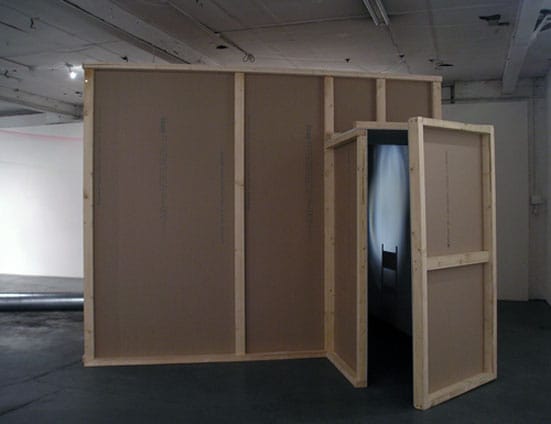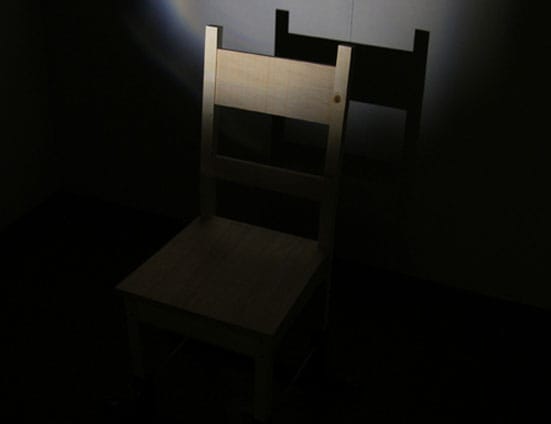Mark Selby is a methodical man. If you get up close to one of his sculptures' you'd be forgiven for thinking they could have been produced by your granddad in a fit of DIY perfection' lots of ply and counter sunk gleaming brass screws' they almost give you a cheeky nod that says "they don't make things like they used to' eh."
But then you feel a sharp kick' you start to process their very deliberate placing' the semiotic codes' a narrative unfolds and you realise that if your granddad did make these' he is a very dark man indeed. His practice is meticulous' perhaps borderline pathological. The short of it is' collaboration and the work of Mark Selby are not easy bed-fellows in my mind.
But Collaboration is in vogue again; it's joined the list of nouns that you have to stick in an Arts Council application and inevitably every fucker's at it. And' it's even permeated through to Selby' via his new show at The Schwartz Gallery. The concept: the Gallery's two collaborative curators' Patrick Michalopoulos and Ismail Erbil' pool together a list of artists they want to show for the year' they then pair artists off together for a two person show at the gallery.
The catch is that you don't find out who you are working with until you've agreed to exhibit. He's a braver man than I. (Having just completed a 6 month collaboration with a very close friend and finding the process of relinquishing control so unbearable that for weeks after I was adamant I was going to move to the country and make hats in isolation for the rest of my days.)
The expectation is that the two artists collaborate' both together and with the curators to make new work' questioning the exhibition-making process. I ducked and dived my way through the work at the Schwartz gallery to talk to Selby about his collaborative experience.
CF: Do you think genuine collaboration is possible?
MS: 'Genuine' collaboration for me involves being open in allowing the prescribed borders of your own artwork be up for debate' negotiation and discussion. Placing your cards on the table and allowing others to see the hand you are playing with. Very often artists keep their cards close to their chest' which is understandable when dealing with something that is largely personal and originating from the self. In this sense' the Schwartz show was akin to overlapping two practices' a collaboration not in 'combining' but the interweaving or folding of distinct practices into a singular exhibition.
CF: And I suppose this is key to what Patrick and Ismail are getting at' focusing not on collaboration within the work but at almost every other stage of putting together an exhibition' which is obviously very different from thrusting to practices together. Before the show what was your experience of collaborative working?
MS:I have often felt the current dominance of the curator has in some ways instigated a patriarchic system in exhibition-making practice' one that closes discussion amongst participants to maintain a unity of direction. I have been involved in group shows with an over-arching theme dictated by a higher power' whereby the possibility of the work being squeezed in or had its conceptual complexity simplified to 'fit'' suddenly magnifies. This is not to say this format is necessarily unsuccessful' I have had highly productive discussions in this way' but that the two-person model certainly opens up the opportunity for a more direct and democratic communication methodology. It seems to occupy an interesting area between the solo and group show' between autonomy and collaboration.
CF: Totally' and perhaps the key is that it is neither one of those things. But you were working with someone who you don't know' who's practice you are not familiar with and who has been chosen to work with you by two people that you yourself are only just starting a dialogue with. Being as honest as you can be in an article that you know she will read' how did you feel when found out you were working with Kate Terry?
MS: I found some images of Kate's work before our initial meeting and my core concern was that our work would operate in too much of an oppositional binary dialogue. Perhaps too simply gendered in some way in material and identity' between the stereotyped feminine symbolism of thread and the male use of wood for example. Thankfully' this was a concern both Kate and I felt. It was clear there was a more profitable area to develop' though it took some thought and discussion to isolate what the parameters of that might be.
CF: What do you think Patrick and Ismail expected you to do' was there ever a chance that they would simply veto something they didn't like?
MS: I don't think there were any specific expectations and the power balance' in terms of the aesthetic' conceptual and compositional decision making process for the exhibition' was squarely put into our hands. If I had felt that Patrick or Ismail would have vetoed a decision at any point' the design behind their two person model would have failed in its ambition.
CF: Did you ever just feel like there were too many people involved?
MS: Once the introductory meeting with Kate had occurred' that Patrick and Ismail set up' they seemed interested in observing the productivity of our discussion and I must admit' showed great confidence (and lack of ego) in allowing us to get on with it. I certainly never felt like there were too many voices.
CF: It seems like Patrick and Ismail play the parents who let two kids play and wait to intervene when necessary! Walking round the show felt like navigating a kind of art assault course' who decided to use the space in that way' was there a sense of you and Kate uniting by making things deliberately difficult?
MS: Yes' definitely. A consideration of the physicality of the viewer' how they could complete the work through their presence' their navigation or discovery as a physical interlocutor within the work' was the area Kate and I highlighted as most important. I had an installation in mind' one that required a communication between two interlinked areas of 'activity' that would be separated by some distance' and Kate had talked about making the viewer duck' bob and weave between the new enclosures her thread installations create in the space. By overlapping these two' we could make the viewer physically work to see the whole exhibition' which is of course set against a backdrop of easy consumption in the practice of everyday life. In constructing and adopting this slightly slapstick' anti-lackadaisical stance' there was a shared exploitation of a wry humour or playfulness; not dissimilar to the employment of comic technique' in asking the receiver to follow the meandering of a joke to reach an ultimate punch-line or reveal.
CF: It's seems to me that this is again another form of collaboration' with the viewer' but the difference is its a much more heavy-handed one. It seems to suggest' a kind of binary proposition; Play the game and see the work or have a beer in the corner and don't. The way I felt I reacted to yours and Kate's obstructions were totally different physically with your work there was just no leeway but must say the fragility of Kate's work brought out the mischievous' destructive side in me' because I could have broken them so easily! Would you get involved in another show that followed the Schwartz gallery format?
MS: I would. A periodical questioning of ones own rules through this kind of collaborative dialogue is a useful' if not necessary' undertaking to resist entrenchment or isolation. I don't see myself as working under a collaborative umbrella but I certainly enjoying taking advantage where the situation and circumstance allow. Of course' the level of success depends on an equal agreement with the other person or persons.
For further images and information please see Mark Selby's website www.manifesto-art.co.uk
The Schwarz Gallery two person shows continue throughout the year' www.schwartzgallery.co.uk
Corinne Felgate

Help Me Help You 2010
Wood' Plasterboard' Aluminium Tube' Slide Projector' Motor' CCTV Camera and Monitor
Dimensions Variable

Help Me Help You 2010
Wood' Plasterboard' Aluminium Tube' Slide Projector' Motor' CCTV Camera and Monitor
Dimensions Variable
Schwartz Gallery

Help Me Help You 2010
Wood' Plasterboard' Aluminium Tube' Slide Projector' Motor' CCTV Camera and Monitor
Dimensions Variable

Help Me Help You 2010
Wood' Plasterboard' Aluminium Tube' Slide Projector' Motor' CCTV Camera and Monitor
Dimensions Variable